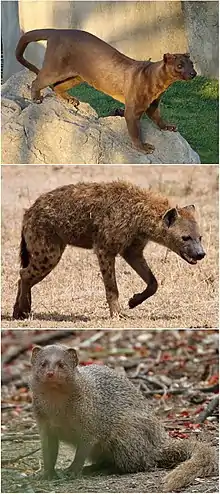| Herpestoidea | |
|---|---|
 | |
| Top to bottom: Fossa, spotted hyena, Indian grey mongoose | |
| Scientific classification | |
| Domain: | Eukaryota |
| Kingdom: | Animalia |
| Phylum: | Chordata |
| Class: | Mammalia |
| Order: | Carnivora |
| Suborder: | Feliformia |
| Parvorder: | Viverroidea |
| Superfamily: | Herpestoidea Bonaparte, 1845 |
| Families | |
| |
| Synonyms | |
| |
Herpestoidea is a superfamily of mammalia carnivores which includes mongooses,[2] Malagasy carnivorans[3] and the hyenas.
Herpestoids, with the exception of the hyenas, have a cylindrical and elongated body, which allows them to get into holes to catch prey.[2] Herpestoids are feliforms and most of them specialize in hunting animals bigger than they are.[4]
They live throughout Eurasia, Africa and the island of Madagascar.[4]
Classification
- Superfamily Herpestoidea
- Family Eupleridae (Malagasy carnivorans)
- Family Herpestidae (mongooses and allies)
- Family Hyaenidae (hyenas and aardwolf)
- Family †Lophocyonidae
- Family †Percrocutidae
Phylogenetic tree
The phylogenetic relationships of Herpestoidea are shown in the following cladogram:[5][6]
| Herpestoidea |
| |||||||||||||||||||||
References
- ↑ Zhou, Y.; Wang, S.-R.; Ma, J.-Z. (2017). "Comprehensive species set revealing the phylogeny and biogeography of Feliformia (Mammalia, Carnivora) based on mitochondrial DNA". PLoS One. doi:10.1371/journal.pone.0174902. PMC 5373635.
- 1 2 Wozencraft, W. C. (2005). "Family Herpestidae". In Wilson, D. E.; Reeder, D. M. (eds.). Mammal Species of the World: A Taxonomic and Geographic Reference (3rd ed.). Johns Hopkins University Press. pp. 562–571. ISBN 978-0-8018-8221-0. OCLC 62265494.
- ↑ Wozencraft, 2005, pp. 560–561
- 1 2 Smith, S. All about Herpestoidea. pp. 150–231. Retrieved 08.31.2018
- ↑ Barycka, E. (2007). "Evolution and systematics of the feliform Carnivora". Mammalian Biology. 72 (5): 257–282. doi:10.1016/j.mambio.2006.10.011.
- ↑ Morales, J.; Mayda, S.; Valenciano, A; DeMiguel, D.; Kaya, T. (2019). "A new lophocyonid, Izmirictis cani gen. et sp. nov. (Carnivora: Mammalia), from the lower Miocene of Turkey". Journal of Systematic Palaeontology. 17 (16): 1347–1358. doi:10.1080/14772019.2018.1529000. hdl:10261/223616. S2CID 91268744.
This article is issued from Wikipedia. The text is licensed under Creative Commons - Attribution - Sharealike. Additional terms may apply for the media files.